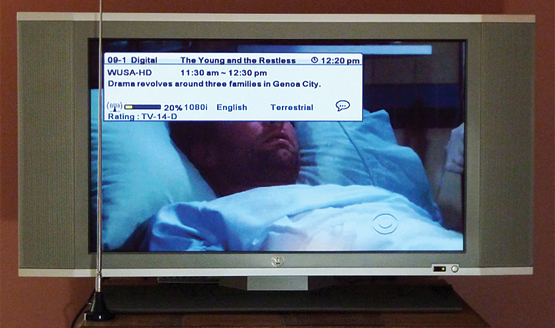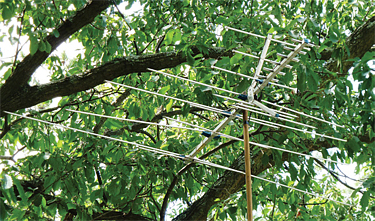Exploring the Off-Air DTV Dilemma
ALEXANDRIA, VA.
More than a year after the big switch was thrown from analog to digital, the dust has mostly settled with regard to reception of digital TV transmissions. Certainly there are people with serious reception issues, but I've heard precious little when walking through stores and skimming online DTV forums.
There are probably a few reasons why there was little complaining. One reason getting short shrift is that pictures from digital TV stations look so good, especially if they are in high definition. People like to think they're getting a fair deal with the HD offerings, and are willing to accept occasional loss of signal when the pictures look great most of the time.

With this simple stick antenna, WUSA (Channel 9) from Washington had considerable break up, but many other channels were fine. Another reason is that there are more channels. I can reliably receive 15 different digital stations with my modest rooftop antenna in this Washington, D.C. suburb, and these stations carry 42 discrete programs that vary from entertainment to weather to foreign to all-talk. In an era of 500-channel cable systems, 42 different program feeds may not sound like much, but it is a bargain at the price: free.
WHAT CAN YOU RECEIVE?
Still, the question "what can you receive and how do you receive it" is a good one. I checked my reception to determine what could be received with a simple stick antenna and what improvement occurred when a reasonable rooftop antenna was connected instead.
My home is just inside the Beltway that circles Washington. It's about 10–15 miles from the market's TV transmitting towers, and the terrain here is generally rolling. Thankfully, I'm at a fairly high point in my neighborhood.
The signals reach me from a mix of locations. Tower heights are significantly restricted in the Washington area, and only one station operates with a tower that's even close to 1,000 feet in height. This means that reception in the Washington area is somewhat crippled due to low-transmitting antenna heights.
The stick antenna I'm using with my set has a weighted magnetic base and extends to 25 inches. With this antenna connected, I checked the TV band to see what I could receive.
I'm using a Channel Master CM-7000 DTV converter box—one that could be bought at the beginning of 2009 for 10 bucks, plus a $40 government coupon. I chose the Channel Master unit because it was one of the few DTV converter boxes with an S-video output, and S-video clearly makes better pictures than composite video.
With this simple antenna and no experimentation to find the best position, I received seven stations perfectly. In addition, another three stations that registered 80 or higher on a scale of 100 on the receiver's quality meter all produced solid pictures with no break-up. These 10 stations account for about 30 different program feeds—all received solidly with an exceedingly simple antenna and no attention whatsoever needed with regard to placement of that antenna.
Interestingly, two stations that weren't received well with the stick antenna were the two major network affiliates that moved their DTV transmissions from temporary UHF slots back to their analog VHF channels positions, 7 and 9. Since they represent the ABC and CBS networks in Washington, their loss is significant. With the stick antenna, both suffered continuous breakup.
UP ON THE ROOF
Things improved substantially with a rooftop antenna, despite the tall, leafy trees that surround my home. This particular antenna was installed in 2002 and is still in good condition. It's mounted on a mast attached to a chimney, and positioned about six feet above the chimney. About 70 feet of RG-6 coax connects the antenna with the receiver.
Using this antenna, all 15 stations were received reliably. This includes two Baltimore stations, WMAR-TV and WBFF, which are located about 40 miles away. WMAR-TV, which operates on Channel 38, had some occasional momentary breakup, but it wasn't bad enough to ruin the viewing experience. WBFF, on Channel 46, was rock solid.
Of course, the weather can wreak havoc with UHF DTV signals and the sky was generally clear when I did my informal testing. And mine was just one unscientific test for DTV reception, with no attempt to gather hard data, but rather to see what the viewing experience was like.
With analog TV transmissions, a rooftop antenna was needed in my neighborhood to avoid ghosting and interference from frequent overhead aircraft. (My home is located near a major regional hospital that accepts patients delivered via helicopter.) As described, with digital transmission, many of the area stations could be received perfectly with a simple indoor antenna, but a few couldn't be received at all.
Cable penetration is heavy in my area. In fact, I have a cable connection (Verizon's FiOS) for my main TV in the living room, but use off-air signals for the bedroom. If all you want is to be able to receive one of the 11 p.m. local newscasts, a simple rabbit-ear antenna will probably suffice. If you want to reliably be able to check who's on Letterman versus who's on Leno, you'll need a rooftop antenna.
RURAL RECEPTION

With this antenna at my suburban location, solid reception is available on 15 channels carrying 42 different program feeds. I also have experience with DTV reception at a home in the mountains of rural Virginia, with signals there more difficult to come by. If you don't have service from a satellite provider (and cable isn't available), you better have a large antenna and a rotor. However, this was also required for analog TV reception.
In the mountains, the biggest DTV loss was on the low-band VHF Channels 3, 4 and 5. In the analog days, I could point the antenna and get decent signals from Washington Channels 4 (WRC-TV) and 5 (WTTG), as well as Channel 3 (WHSV-TV) in Harrisonburg, Va. Those stations are affiliates for NBC, Fox and ABC, so their loss in the digital era is significant. I can get the NBC affiliate in Hagerstown, Md., WHAG-TV, but can no longer receive any ABC, CBS or Fox affiliated stations.
Fortunately for me, this rural home is primarily a weekend place. However, for my full-time neighbors, the only solution was satellite TV. None of them wanted to deal with buying and installing a large antenna and the hefty rotor that would be necessary to point it.
The change to DTV has been a mixed bag for me. Like so many others, I love the quality of HD viewing, and marvel at how easy it is to receive lots of signals in the suburbs.
Once out of the suburbs, reception is much more difficult and there are no easy solutions. Analog stations that provided viewable (although far from excellent) reception are now simply not there in digital. The solution for many people in rural locations, including me, is to spend more time on the Internet and less time watching TV—good for Google; bad for broadcasters.
The transition from analog to digital broadcasting was never going to be perfect. Depending on where you live, your reception experience could be more or less perfect than others living just a few miles away.
The ability to pull a viewable picture from the snow of a marginal analog signal is something that digital doesn't support. If you live in the suburbs, you are probably among the DTV reception "haves." Please spare a kind thought for the "have nots" in more rural areas.
Get the TV Tech Newsletter
The professional video industry's #1 source for news, trends and product and tech information. Sign up below.
Bob Kovacs is the former Technology Editor for TV Tech and editor of Government Video. He is a long-time video engineer and writer, who now works as a video producer for a government agency. In 2020, Kovacs won several awards as the editor and co-producer of the short film "Rendezvous."

